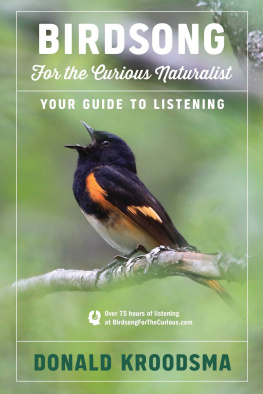Phantoms of the Woods
T he gentleman had phoned the Massachusetts Division of Fisheries and Wildlife with great excitement. Youre not going to believe this, he told the switchboard operator, but Ive just seen a kangaroo out my window.
Tom French, assistant director of the Natural Heritage and Endangered Species Program, had heard it all before: the Asian pit vipers that turned out to be garter snakes, the black panther that was really the neighbors house cat backlit by the morning sun.
Of course it wasnt a kangaroo.
It was a wallaby.
Kangaroos can grow to four and a half feet tall. Wallabiesone of the fifty or so Australian variations on the kangaroo themeare much shorter. This animal was two and a half feet tall, jumped around on its hind feet, and at least twelve people reported it hopping around the streets and yards of Acton, Foxboro, and Concord, Massachusetts, in 1989. In other words, several continents beyond its usual range.
This isnt the first time such a thing has happened. Other strange sightings have included an armadillo scuttling around an East Coast office and a flamingo in a pond in Vermont.
It could be cabin fever. But there is another explanation for these phantoms of the woods: You really can be seeing what you think youre seeing, says Eric Orff, a wildlife biologist with the New Hampshire Fish and Game Department.
True, Orff also got a call from a police chief who said he had seen a Yeti, which Orff doesnt believe. But between escaped zoo animals, unwanted pets and creatures undertaking pilgrimages we dont understand, its possible to see almost anything in your backyard.
According to French, most of the more interesting, real records occur at the end of the winter, beginning of springright about now. In March, storms blow through bearing strange birds, visibility is good because the trees are bare, and animals everywhere are on the move.
By the way, that wasnt the first wallaby reported in the Boston area in recent yearsnor was it the last. Oddest of all, in only one instance could authorities match the wandering wallaby to a known case of a missing marsupial: Aardu, an eighteen-month-old male Bennett wallaby, escaped from Bostons Stoneham Zoo in July of 1990 and was spotted repeatedly by residents of Malden, Melrose, Medford, Stoneham, and Winchester during his eleven-day hopping spree until his safe recapture August 3. But there were other wallaby sightings reported in the towns of Southwick and Springfield that August, according to French, and an earlier one reported in Belchertown in the 1970s. These were, says French, reliable sightings, reported in accurate detail by multiple, independent sources. And like the Acton wallaby of 1989, no one ever figured out where these animals came from, or where they eventually went.
The wallabies were for real, French believes, and not cases of mistaken identity. But people do make mistakes. Recently, a lady from Cape Cod called the state Fisheries and Wildlife office to report she had found a dead bald eagle on the beach. Since this is an endangered bird seldom seen in Massachusetts, French persuaded her to collect the corpse, bring it back to the house and then describe it to him on the phone.
Can you tell me what its head looks like? he asked.
Its got a big white head, she answered.
And its beak?
Its got a big curved yellow beak, the lady said.
What color is its body?
Its got a black body, she reported.
All these are indeed characteristic of adult bald eagles. French thought a moment. He asked one more question:
Does it have webbed feet?
Yes, responded the lady enthusiastically, it has the webbed feet. It was a black-backed gull.
Identifying birds can be confusing. A lot of reported hawks tum out to be ruffed grouse. Both are big birds with banded tails, big talons and curved bills. (Although it might seem more exciting to have found a bird of prey, if it turns out to be a dead grouse, you can eat it.)
Some of the weird things people see are regular animals in varying degrees of hairiness, says Orff. Mange can transform a fluffy fox into an unidentified cat; with its winter coat fluffed up, a skunk can appear as big as a fifty-pound wolverine.
One of the most common errors people make when describing an unknown wild animal is making it bigger than it really is. Minutes after Vermonts Fish and Wildlife Department released some martins, little red tree-dwelling weasels who had become extinct in the state, a passerby spotted one of them. He reported a thing the size of a cocker spaniel with a long tail, said Steve Parren, coordinator for the Departments NonGame and Natural Heritage Program. The martin, Parren added, was actually about the size of a squirrel. (To gauge a creatures size accurately, try to note where it measures up to a bush, tree, or fence it may be standing near, and then go measure that object.)
In the eyes of the public, many creatures not only grow larger, but also become more exotic. Unfortunately we get our nature education through television, says French, and we tend to see the characters we see on TV in our backyards. So Easterners tend to phone in insisting theyve seen a badger, a big, western hole-digging weasel, when theyve really got a woodchuck. One Massachusetts resident reported he had an armadillo in his yard. It was actually a possum.
But it could have been an armadillo. Thats what ran into Mark Pokrass office one wintry day. A horse had come in from Florida for treatment at the veterinary clinic at Tufts University, where Pokras is an assistant professor of wildlife medicine. When the walkway from the horse trailer was lowered, out came the armadillo.
Exotic birds may also make long trips, blowing in with stormsthe way Dorothy arrived in the land of Oz. Thats how Vermont authorities account for the flamingo that appeared in the summer of 1980 at the mouth of the Winooski River, where it flows into Lake Champlain.
And a lot of odd creaturesand this probably includes the unexplained wallabiesare likely pets people bought impetuously, sometimes illegally, and later just released. This occurs frequently with reptiles, particularly bad-mannered ones, such as the four-footlong Savannah monitor that was discovered walking along a sidewalk in Worcester, Massachusetts, by a dog officer a few years ago. Although a sleek, handsome creature, light tan with yellow speckles, as a pet the Savannah monitor has its drawbacks. This is a nasty, nasty lizard with lots of sharp teeth, Pokras explains. They bite you. They thrash their heads around like a shark and it really hurts. Tufts has recovered as many as six loose Savannah monitors in a given year. When one is captured, a veterinary student usually adopts it as a pet.
Not all phantoms are wayward pets or unwitting vagabonds. Some turn up on purpose, sometimes through efforts that seem heroic.
Until the early 1990s, lynx had not been positively identified in southern New England since the 1800s. About the size of the more common bobcat, the buff-colored, short-tailed lynx, with its distinctive triangular ears tipped with tufts of black hair, has been so widely hunted that its been almost exterminated from the United States. The only large American populations survive in Alaska, Montana, Idaho, and Washington.
In an effort to reintroduce lynx to the region, in 1988 and 1989 New York State biologists released wild-caught, radio-collared lynx from Alaska and the Yukon into the Adirondack wilderness. Some of them reached Massachusetts, Vermont, New Hampshire, and even Pennsylvania. In all these states, lynx have been positively identifiedunfortunately because wildlife authorities examined the corpses. One was killed by a car in Pennsylvania; three were shot while raiding chicken coops. Two of the animals were wearing radio collars. There could well be other lynx in surrounding areas, undiscovered, phantoms of the woods.
















